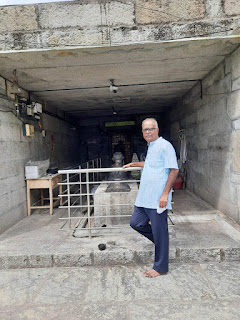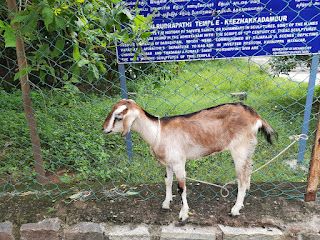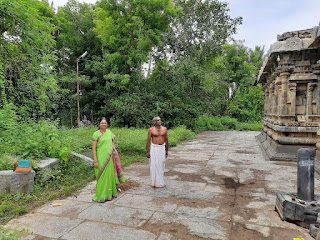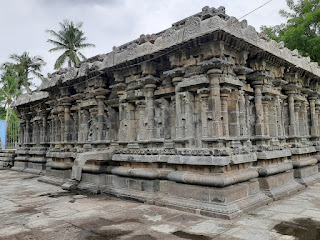Keezh Kadambur
Keezh Kadambur is about 15 min drive from Kaatumannar koil.
I was excited to see the Kadambur Maaligai of Ponniyin Selvam fame where so
many incidents have happened. I was hopeful, of seeing the ruins at least if
not for the palace. The locals had no clue about palace or ruins or Ponniyin
Selvan! One man stopped his bicycle to reply to our query…"Temple..? Left side
is keezhkadambur, ASI site and if you go further down is Mel Kadambur which is
a bigger temple". Since he mentioned ASI, we decided to visit that temple first.
It was on a deserted little road with a locked gate. Two ladies with 3 little
girls were there in the vicinity. They gave us the number of the caretaker
Rajendran but his number was not reachable. One local seeing our disappointed
faces offered to go and bring the caretaker and within 5 minutes the caretaker
Rajendran arrived on a two wheeler with the keys.
It was a Shiva temple, called Rudrapathy temple. Rajendran
seemed like a seasoned tour guide. He said indeed this was the place where the
Kadambur Maaligai stood, but sadly there is not even a brick to show its
existence. I just stood there imagining Vandhiya Devan in the earlier part of of PS entering the palace and his friend Kanda Maaran
taking him to see his father Sambuvarayar.
I asked Rajendran about the secret passage which is there in the Garba Griham of the main deity, (I had read about it) doubting whether he will show us…but I was surprised as he said come on in…we both stepped in, did a pradakshinam of the huge shiva lingam and on the other side was the passage which supposedly leads to Gangai Konda Cholapuram 15 kms away.
The Secret Passage
The Rudrapathy temple is a Ilangkoil meaning temporary place of worship till the main temple gets renovated. This temple has many Nayanmars in sculpture form carved beautifully. There were lots of statues placed on the ground. Rajendran said they were stolen earlier but retrieved back but yet to be installed in their rightful place. The sculptures were made of soft stone and when tapped on, emitted musical notes. Rajendran demonstrated this. Sounded amazing.
He also described how Director Mani Rathnam (who is in the process of
taking Ponniyin Selvan, the movie) and his team came to this place asking for
the Kadambur Maligai. I believe the team was crestfallen that nothing remained today.
They videographed the place including the aerial view using a drone camera.
You can connect with Rajendran, Rudrapathy Temple, Keezhkadambur: 9943433058
Melkadambur:
We next drove 1.5 kms to the Amirtakadeswarar temple at
Melkadambur. This seemed like a living temple with devotees and poojas
happening. This temple shaped like a chariot (Kaarakoil) was built by Kulothunga
Chola 1 in 1113 AD
Lots of legends surrounding this place. One such fascinating legend happened during the churning of the ocean. The nectar or the Amritam which came as a result of the churning was consumed by the devas without giving due respect to Lord Ganesha, the angered elephant headed God took the pot away from the devas. When he was passing by this place, a drop of Nectar fell here which became the Swayambu (came on its own) Lingam. The Devas headed by Indira followed Lord Ganesha asking for forgiveness. They were pardoned by him only after getting assurance to offer prayers to Amrithakadeswara the Shiv Lingam in this place. The pot of nectar was also duly returned to the devas. The Shiva Lingam is said to be made of Navabashana or nine herbs.
Lord Indira and Melkadambur
Lord Indira’s Mother Aditi used to come to this place to offer prayers everyday. Lord Indira did not want her to travel so he converted the temple into a chariot and tried pulling it to Devaloka. Lord Ganesha pressed the chariot with his leg and Indira was unable to move it. (Even today you can see one chariot wheel sunken to the ground) Ganesha instructed Indira to create one shivalingam in one naazhigai (24 min) Indira started creating but each and every lingam he created developed cracks. Finally, Indira realized that it was an impossible feat and begged forgiveness. Lord Ganesha instructed Indira to create one Shivalinga chanting the Lords name 1000 times and do pooja to this lingam everyday. It is believed that Lord Indira even today, visits this temple to perform the shiva lingam pooja
The Sunken Chariot Wheel
The sculptures were simply breathtaking and we did know where
to look…wherever we turned there was something there for us to stop and stare.
The Aaravaraa Vinayagar has his trunk aloft and looks like
he is trumpeting with his head leaning towards the left. This Ganesha idol has
been brought from Vatapi, present day Badami in Karnataka, as spoils of war. There
were several such Ganeshas brought from Vatapi although some historians refute
this. (Readers might remember the famous Ganesha in Kalki’s novel Sivagamiyin
Sabatham which Paranjothi brought and installed in his home town, Thiruchenkaatankudi)
The Goddess
VidhyujothiNayagi /Jothi Minnamai gives darshan to the devotee as Saraswathi in
the morning, Mahalakshmi during midday and Shakthi in the evening.
Mel Kadambur has a Dasa Buja Rishaba Thandavamurthy (Nataraja)
statue a Pala Sculpture brought by Rajendra Chola after war. It’s a beautiful idol
brought for darshan only during Pradoshams.
A very peaceful place with plenty of vibrations. Do request the head priest to narrate this temple’s specialties.





































































